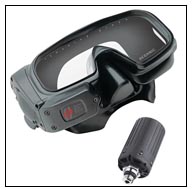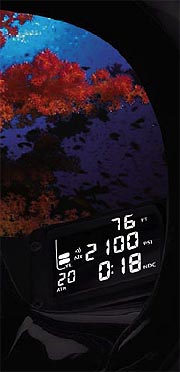« Nitrogen Narcosis | Main | Pony bottles -- a good thing to have, or not? »
November 22, 2007
Oceanic Datamask: MUST - HAVE - IT - NOW!
A couple of weeks ago I received an email invitation to the Grand Opening of a new dive shop, Fish Eye Scuba, in my town. Timing was bad as I had planned on going racing that afternoon and evening and so I thought I'd probably stop by the new shop some other time. Well, on my way to the track, the car wasn't running right and I decided it'd be too risky to push things at the race track. As luck would have it, the new dive shop was on my way home, and so I went to check it out.
I love dive shops as much as book stores and maybe more. Whenever I go to one, I never spend less than an hour or two perusing all the gear, asking a bunch of questions, compare notes and all the fun stuff we do in dive shops. And I almost always end up buying something that I may or may not need, but that I absolutely have to have.
I was early and they were still gearing up for the Grand Opening. So they set up all the food and drink, and a disc jockey prepped his gear. I got a chance to meet the owners, chat a bit and then look around while the place wasn't totally crowded yet. It wasn't a large store, but it was neatly laid out and decorated, had lots of interesting gear, and some of the high tech touches I am a sucker for. A huge flatscreen ran underwater footage in glorious high definition.
So I grabbed a sandwich and a bottle of water and checked out the gear. They are not a Scubapro dealer, unfortunately, and 90% of my gear is Scubapro, but I love to look at and try out new stuff. By now people were trundling in, greeting and hugging each other and soon the place was packed.
That's when I saw it. In a locked glass case.
 It was the Oceanic Datamask, a combination of mask and dive computer. My Open Water class instructor, Chuck Odell, had mentioned it to me early on. As a former Navy SEAL he was close to such things and I think he may have mentioned that he'd get one of the first ones. That's because the Datamask began life as a joint development project between Oceanic and the US Navy's Coastal Systems Station. Its original name was the "Combat Diver Display Mask". The idea was to combine mask and computer, have an optical readout right in the field of vision of the diver, thus reducing the need to interrupt operations to look at a wrist-mounted dive computer. One might argue how important that is in the larger scheme of things, but it is certainly high-tech and a fascinating idea.
It was the Oceanic Datamask, a combination of mask and dive computer. My Open Water class instructor, Chuck Odell, had mentioned it to me early on. As a former Navy SEAL he was close to such things and I think he may have mentioned that he'd get one of the first ones. That's because the Datamask began life as a joint development project between Oceanic and the US Navy's Coastal Systems Station. Its original name was the "Combat Diver Display Mask". The idea was to combine mask and computer, have an optical readout right in the field of vision of the diver, thus reducing the need to interrupt operations to look at a wrist-mounted dive computer. One might argue how important that is in the larger scheme of things, but it is certainly high-tech and a fascinating idea.
So they did it, and the civilian result of it is the Oceanic Datamask HUD, with HUD standing for Heads Up Display. It's been available from Oceanic since early 2007 or so, and the company has been demonstrating it at dive shops and scuba get-togethers. I had never seen it in person, but now here it was, in that glass cage.
One of the Fish Eye Scuba sales staff was kind enough to open the case for me and a couple of other interested parties and so we got to check out the Datamask. At first sight it looks like a regular single-lens black rubber/silicone mask, but then you discover that there's more to it.  There are some protrusions on the right side, and the lens is asymmetrical, with the right side of the glass area being smaller than the left. That's to make room for the electronics and also the integrated LCD screen. Doesn't that make the mask heavy and bulky? Amazingly not. The mask really feels like any other mask, it has fairly low volume (which I like), and it has excellent fit, with a well designed skirt.
There are some protrusions on the right side, and the lens is asymmetrical, with the right side of the glass area being smaller than the left. That's to make room for the electronics and also the integrated LCD screen. Doesn't that make the mask heavy and bulky? Amazingly not. The mask really feels like any other mask, it has fairly low volume (which I like), and it has excellent fit, with a well designed skirt.
I should mention here that the Datamask is both air-integrated and wireless. It comes with a wireless receiver that screws into the regulator's first stage. If you wear both the Datamask and a conventional wireless dive computer as a backup, the signals won't cross as they operate on different frequencies.
So how does it all work? Well, it's simply a case of the functions of a modern dive computer being built into the mask. If you look straight ahead, you have the same unimpeded field of vision as with any other mask. If you want to see the computer, you look down to the lower right. This is where the LCD screen sits, but you don't really see it as an LCD screen. It feels more like the data is floating ahead of you in space, or rather in the water.
How do you operate it and what can it do? Here, the Datamask's designers came up with an ultra simple method that uses just two buttons, one on top of the mask and one on the side. Each button has two functions: push and release, and push and hold. Those two buttons control all of the functions and display modes of the Datamask. Like all dive computers, after initial setup it'll simply work if you put the mask on and go dive, but if you want to really use its features, there'll be a bit of studying and practicing. And maybe quite a bit. The Datamask (which is Nitrox compatible up to 50%) has a significant number of screens both for setup on the surface and then for diving. It has automatic altitude adjustment, the main battery in the mask lasts about 160 dive hours and the one in the transmitter 1500 hours, it can store 24 dives and comes with a USB interface cable and software for data analysis on a PC. Setup lets you select alarms, units, sampling frequency, lighting, a concervative factor, and tons more.
When you dive with the Datamask, there's a main screen that displays the usual primary data: depth, air pressure, remaining dive time, air time and a tissue loading bar. Push a button and the display goes on to three additional screens with more data. Those then revert to the main screen. There are also screens for safety stops and deco stops.
Now obviously, I have not (yet) been diving with an Oceanic Datamask and so cannot say how it all works in real life. I do know one thing, and that is huge for me. While I have 20/20 vision I do need reading glasses, and that is forever a pain with wrist-mount dive computers. I tried stick-on lenses that either seem to be in the wrong spot (often due to the design of the mask lens) or come off (at times because manufacturers edge writing on the inside of the mask exactly where the stick-ons are supposed to be). No good. I tried masks with magnification windows pointing down, and found that distracting. Amazingly, I can see the HUD display of the Datamask clearly and in perfect focus! That alone would make me want one!
How DOES it work in real life? Well, I searched the web for reviews and found surprisingly little. A couple of people had used it during one of Oceanic's demo tours and written about it. There was one single actual review of the Datamask. It was fairly brief. The reviewer found the mask amazingly easy to use, felt that the LCD display was unexpectedly basic and at times difficult to read, that pushing buttons on the mask was a bit weird at first, that having one's computer inside a mask made it impossible to show it to the dive buddy, and that a backup was a good idea in case the mask comes off. And he wondered how it works with thick gloves on. All in all, he liked it. On various scuba bulletin boards others had issued various sight-unseen opinions: Too expensive. Can't do this, can't do that. I'll wait until they come down in price.
So what's the price? Well, currently US$1,495. That's one expensive mask, of course, but then again, no more expensive than my own UWATEC dive computer and Scubapro Frameless mask combined. So there.
The guys at the dive shop offered me a deal and I came THAT close to whipping out my VISA card right then and there. I really want that mask. I wish Oceanic would let me test one. Hey, after all I have written over a thousand published reviews of electronic gear. But the scuba industry seems stingy with eval units and so I may have to buy the Datamask after all.
Posted by conradb212 at November 22, 2007 6:23 PM








